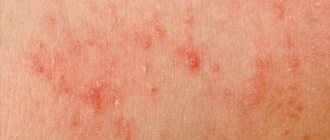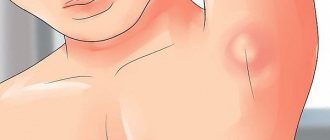The skin is a protective barrier that prevents pathogenic bacteria and viruses from entering the body. In the genital area, the epidermis is especially sensitive, so it is here that rashes and redness often occur. An infectious rash is dangerous to a woman’s life and sexual health. Therefore, at the first signs of damage to the skin and mucous membranes in the groin, you should consult a doctor as soon as possible.
Medical specialists will help identify the cause and prescribe effective treatment for rashes in the genital area.
Causes of rashes in the intimate area
The content of the article
In women, rashes of various types most often appear on the pubis, genitals, and perineum. These can be ulcers, spots, pimples and other visually noticeable skin lesions. These manifestations may be associated with frequent shaving, mild allergies, and poor hygiene. However, quite often rashes in the intimate area require medical attention, as they become a response to infection.
The appearance of an unpleasant rash in the intimate area is associated with the following factors:
- Infection
. The nature of the rash depends on the type of infection that is actively multiplying in the body. Infection with a sexually transmitted infection is usually accompanied by additional symptoms. This may include purulent discharge, itching in the groin, and menstrual irregularities. - Weakening of the immune system
. This factor allows opportunistic flora to actively reproduce. Chronic diseases, antibiotic treatment, chemotherapy, childbearing, and hypothermia seriously weaken the immune system. - Chemical burn
. Aggressive substances destroy the upper layers of the epidermis. The body responds to this with the appearance of small, painful pimples. - Synthetic underwear
. Sometimes it causes genital allergies. Poor quality fabric does not allow the skin to “breathe”, which leads to the proliferation of pathogenic flora; - Ignoring hygiene rules
. This creates favorable conditions for viruses and bacteria to enter the body. It is especially important to carefully observe intimate hygiene during menstruation.
Causes of irritation in the bikini area
- External factors
Irritation in the bikini area is often caused by mechanical damage to the skin. After shaving the intimate area, redness, pimples, and itching often appear - the skin becomes especially inflamed in the summer, when sweating increases. When depilating with a razor, the top layer of skin is damaged, which can lead to dryness and flaking, and growing short hairs cause itching and, accordingly, redness and scratches on the skin.
Expert opinion
Depilation using wax, sugar paste and tweezers damages the top layer of skin to a lesser extent, but more often provokes ingrown hairs. As a result, painful pimples form in the bikini area, the opening of which is fraught with the penetration of pathogenic agents into the deeper layers of the skin (especially in the hot season).
Obstetrician-gynecologist of the highest category Oksana Anatolyevna Gartleb
Violation of the temperature regime that is comfortable for the skin - too high or, conversely, low temperature - can also cause discomfort in the vagina. Of course, external contamination of delicate areas may not be the last cause of irritation.
In addition, discomfort may occur from inappropriate intimate cosmetics. For example, hypoallergenic baby soap, which many women still use as an intimate care product, greatly dries out the delicate skin of the vagina, since the production of sebum by baby skin and the delicate skin of the intimate area occurs in different volumes. It is important to use special products for intimate hygiene - for example, GINOCOMFORT Soothing washing gel consists of natural ingredients that not only delicately cleanse the vaginal mucosa and skin of the labia, but also regulate the acid-base balance that is comfortable for this area.
- Microflora disturbance
One of the most common causes of severe irritation in the intimate area is diseases associated with disruption of the natural bacterial and acid-base balance: thrush (candidiasis), bacterial vaginosis (dysbacteriosis).
These diseases can be caused by a general decrease in immunity, poor diet, sleep, hygiene, frequent stress, taking antibiotics, promiscuity, etc.
Characteristic symptoms include severe irritation in the intimate area after sex, thick atypical discharge with a pronounced unpleasant odor, severe itching and burning. Any of these diseases is treated with special regimens using antibacterial drugs, pro and prebiotics. Self-medication can cause irreversible complications or make the process critical, so it is better to contact an obstetrician-gynecologist to clarify the diagnosis and develop treatment tactics.
- Allergic reactions
Often, intimate itching can occur with contact dermatitis - a manifestation of allergies in a delicate area. One of the most common reasons is scented hygiene products. Fragrance in pads, tampons, and toilet paper is a strong allergen and can cause itching. If you experience irritation in your intimate area, especially during menstruation, try changing your pads - this may solve your problem. In some cases, allergies can be caused by contraception (latex condoms) and lubricants. Most condoms are made from latex.
- Hormonal background
Irritation in the intimate area in women often occurs before hormonal changes: menstruation, pregnancy. Many women are familiar with the sensation of dryness, burning, and severe itching. Irritation in the perineum can be an external sign of hormonal disorders such as hypo- or hyperfunction of the thyroid gland, ovaries, and adrenal glands. To establish an accurate diagnosis, a consultation with an obstetrician-gynecologist and tests for hormone levels are necessary.
Expert opinion
Changes in hormonal levels and the resulting irritation in the intimate area can be triggered by taking oral contraceptives. This situation is especially common if a woman takes OCs, chosen independently or on the advice of a friend, without consulting a gynecologist.
Obstetrician-gynecologist of the highest category Oksana Anatolyevna Gartleb
- Poor intimate hygiene
It is obvious that irregular showering, especially during menstruation, hot weather or after visiting the gym, leads to an increased proliferation of harmful bacteria and fungi, causing rashes and itching in the intimate area in women. Wearing synthetic underwear also has a negative effect - panties made of artificial fabrics do not allow air to pass through, creating a greenhouse effect - an ideal environment for the proliferation of pathogenic microbes. It is important to know that thongs, thongs and similar models are a “bridge” for bacteria from the anus, so if discomfort occurs, it is better to refrain from wearing them.
- Diseases of internal organs
Endocrinologists warn: severe itching and dryness in the genital area is one of the indirect signs of diabetes. Sometimes irritation in the intimate area can indicate anemia, leukemia, immunodeficiency conditions, inflammation in the urinary system, gastrointestinal tract, and cancer. Redness, spots and rashes on the external genitalia occur with eczema (eczematis) and psoriasis (psoriasis).
Of course, you can’t rely only on vaginal itching to make an accurate diagnosis, but this unpleasant symptom can indicate serious health problems, so it’s better not to delay visiting a specialist.
- Sexual infections
Itching, burning and unpleasant discharge after sexual intercourse (especially unprotected with a new man) are accompanying sexually transmitted diseases. They are especially characteristic of gonorrhea (Gonorrhoea), chlamydia and trichomoniasis (trichomoniasis). In addition to discomfort in the intimate area, sharp pain during urination, pain during sexual intercourse and foul-smelling discharge may be added - if these signs appear, you should urgently get tested and visit an obstetrician-gynecologist. Most sexually transmitted infections in the early stages can be quickly and successfully treated, so timely consultation with a doctor can save you from unpleasant consequences and complications.
- Stress
The female genital organs are very susceptible to psychological conditions: emotional instability, stress and frequent anxiety can cause itching in intimate places.
It is important to monitor your stress levels whenever possible and use sedative therapy if necessary to improve your quality of life.
The causes of irritation in intimate areas are varied and may depend on completely different factors. If you feel that self-treatment does not lead to an improvement in the situation, do not hesitate to visit an obstetrician-gynecologist, this way you will quickly determine the cause of the discomfort and get rid of it.
The causes of irritation in intimate areas are varied and may depend on completely different factors. If you feel that home treatment does not lead to an improvement in the situation, do not hesitate to visit a gynecologist, this way you will quickly determine the cause of the discomfort and get rid of it.
Types of rashes in women
Skin rashes manifest themselves in different ways. There are such types of rashes that affect the skin in the intimate area:
- A pimple
is a small bump or nodule protruding above the general layer of skin. The formation is often filled with serous fluid; - An abscess
is a large pimple with a watery texture. The formation is filled with purulent fluid; - Erythema
- bright red spots with clear boundaries. They stand out strongly against the background of healthy skin; - A blister
is a formation filled with fluid. Occurs due to mechanical injuries, burns; - An ulcer
is a non-healing wound that most often forms on the mucous membranes; - Condyloma
is a small formation of the papillary type on a stalk. Localized on the mucous membrane of the genital organs. - A node
is a dense formation in the deep layers of the epidermis. It appears in the form of a tubercle that protrudes above healthy tissues; - Plaque
– multiple formations in the form of small spots. They rise above healthy skin.
A rash in the groin area in women can simultaneously manifest itself in several types of skin lesions. Each type of rash is a signal of developing pathology, poor hygiene, unsafe sex life or other intimate problems.
Pimples and irritation after shaving in the intimate area in women: how to properly remove hair with a razor?
Hair removal in intimate areas is a recent trend. How to avoid irritation after depilation?
- Be sure to apply shaving cream or foam to your skin before depilation.
- If you are removing hair with a reusable machine, treat it with a disinfectant such as alcohol or chlorhexidine.
- Use only a very sharp razor; a dull razor can damage delicate skin.
- Do not press the razor too tightly against the skin or run over one area several times in a row.
- After depilation, treat the skin with a septic cream and do not wear underwear until it dries to allow the area to calm down and not cause irritation.
Rash due to syphilitic infection in women
Syphilis is an infectious disease that is sexually transmitted. This is a dangerous and serious disease that affects the genital organs, liver, and nervous system. Without adequate medical care, a person becomes disabled or dies.
Sexual infection appears 1-2 months after infection. Its first sign is the formation of a dense, hard chancre on the labia or vaginal mucosa. This is the main symptom of the onset of the inflammatory process. After 4-6 weeks, the solid formation disappears. An imaginary feeling of recovery appears.
In fact, at this time the infection is already spreading throughout the body. This is evidenced by a small pink rash in the groin area in women, which appears after 5-10 days. The rash also affects the mucous membranes of the mouth and eyes. With syphilis, small dense condylomas also appear in the intimate area. They are located mainly on the labia and anus.
The rash with syphilis in women does not itch or hurt. The infection is accompanied by abnormal vaginal discharge. Leucorrhoea contains impurities of pus, becomes thicker, and has an unpleasant odor. Whitish papules, ulcers and purulent discharge are characteristic signs of the second stage of syphilis.
In the third stage, the characteristic rash spreads throughout the body. Sometimes the rash goes away, but after a couple of weeks the syphilitic rash in women again covers the entire body.
HIV rash in women
HIV is a virus that destroys blood cells, which leads to atrophy of the immune system. A rash with HIV infection in women becomes an early sign of infection. Papules and vesicles appear throughout the body, including on the genitals. The nature of the rash is always different, since it can be fungal, bacterial, or papillomavirus in nature. The main symptom is the appearance of pathological elements on the skin, which differ in color, structure, density from healthy tissue.
How does an HIV rash appear in women? At the initial stage, large and small erythemas or papular, compacted areas in the intimate area are observed. An erythematous rash on the genitals in women quickly spreads from the perineum to other parts of the body. The rashes do not peel, do not hurt or itch. This type of rash is characteristic of the active development of common infectious diseases (influenza, measles, rubella). Skin pathologies at the initial stage of immunodeficiency are accompanied by candidiasis and fever.
As the disease progresses, the rash takes on a different character. The circulatory system is weakened, so pinpoint hemorrhages appear in place of the capillaries. In the acute stage of the disease, a rash in the groin area in women manifests itself in the form of vesicles and papules. Often they merge, forming large lesions and weeping wounds. Such rashes are characteristic of sexually transmitted infections (genital herpes, gonorrhea). Sometimes a rash on the labia in women manifests itself in the form of folliculitis, which looks like teenage acne.
With immunodeficiency, other types of rashes may appear (seborrheic dermatitis, pityriasis versicolor). The nature of the rash always depends on the type of pathogen.
Is it possible to lighten it if it has darkened?
Darkened skin in the groin can be lightened. And today quite a lot of techniques are already known that can cope with this task. In particular, the following will help whiten your skin:
- Cosmetology procedures. Do not be surprised, the desire to look 100% even in the intimate area is very common, and cosmetologists are happy to meet the wishes of clients.
- Special whitening products that can be bought at a pharmacy or beauty store.
- Folk remedies.
It is worth remembering that the skin in the genital area is quite vulnerable to various types of influences. Therefore, you need to bleach it very carefully, and when using any medications or folk remedies, conduct preliminary allergy tests.
How to get rid of dark spots from a cosmetologist?
To lighten the skin in the perineal area, phototherapy is most often used, in which the skin is exposed to light pulses of a certain length. lanin (coloring pigment) is destroyed, and the surrounding tissues completely retain their integrity. However, soon after the procedure, the treated areas become even darker, which is explained by the coagulation of proteins. After a few days, the top layer of skin peels off, and underneath it a renewed area of natural color appears. Phototherapy is considered very expensive, but can give really excellent results.
To achieve a lasting effect:
- From 3 to 10 procedures may be required.
- It is necessary to perform phototherapy sessions at intervals of 3-4 weeks.
- It is very important to find a qualified specialist who can calculate not only the duration of treatment, but also the optimal wavelength, the depth of its penetration and other subtleties of the procedure.
The positive effect of phototherapy becomes noticeable 2 weeks after the first procedure. It is worth considering that most often light treatment is painless and comfortable, but sometimes the manipulation brings discomfort, causes burning and swelling, which, however, quickly passes.
How to whiten with professional means?
When whitening the skin in the perineum, you cannot use acids or other quite aggressive substances that help fight pigment spots on the body and face. It is important to remember that it is better not to use any local remedies:
- If you suspect the presence of diseases.
- If there are injuries to the skin.
- While carrying a child.
- If you are prone to allergic reactions.
In other situations, specially developed creams and ointments will help whiten the skin in the groin. A dermatologist will help you choose the most suitable product.
On sale you can find different types of whitening products for the intimate area. In particular, it is often recommended to use soap for this purpose. The following will help you cope with this problem:
- Whitening soap Christina Rose de mer. According to the manufacturer, this product copes with many aesthetic problems of the skin and perfectly whitens the skin, helping to eliminate superficial corneocytes. Soap evens out the skin structure, normalizes blood circulation and has an antibacterial effect.
- Enzyme brightening soap Natural Active Enzyme Chrystal Afy. This product contains active enzymes that can block melanin synthesis and eliminate dead skin cells. According to the manufacturer, the soap helps to completely restore the production of collagen protein. This product is recommended for use not only in the bikini area, but also on other parts of the body.
Soap can be used once a day for a month. The positive effect becomes noticeable quite quickly.
Bikini area brightening cream
To eliminate pigmentation in the intimate area, you can use:
- Lakshma maxxi cream. This product is manufactured in the USA and can be used to combat age spots on different parts of the body, including the groin area. Its main components are kojic acid and arbutin. It is believed that the composition of the cream is safe, and the drug does not harm the skin, and also rarely provokes allergies.
- Joydrops cream. This Turkish remedy was originally developed specifically to combat dark skin in the bikini area. The manufacturer assures that the use of this drug allows you to achieve a lasting effect that will last for a long time.
- Cream Achromin. This is a product of Bulgarian origin, which is popular among women, as it is relatively inexpensive and allows you to achieve noticeable results. However, many gynecologists warn against too active use of Achromin in the intimate area, since it contains hydroquinone, which can have a toxic effect.
- Cream Isme. This is a Thai product that contains arbutin with kojic acid, as well as a number of additional components, including green tea extract and aloe plant. The manufacturer claims that its use helps reduce melanin synthesis and lighten the skin.
- Mela Defense White Capsule cream. This product is produced in Korea, and its use, according to the manufacturer, allows you to start the process of skin whitening in the deep layers of the epidermis. The cream has a multi-component composition, containing various plant extracts, amino acids, hyaluronic acid, etc.
- Cream from Eveline “Extra Soft Whitening”. This product can be a wonderful alternative to expensive drugs. It can gently whiten the skin and prevent the appearance of new dark spots in the perineum. But to achieve the desired effect and maintain it, it is important to use the cream regularly.
- Cream t. m. NanoMed “Finale Whitening Cream”. This is an excellent product that can restore normal skin color within 30 days of regular use. The manufacturer claims that the cream is able to activate cell restoration, renew the epidermis and ensure its lightening. But after achieving the desired result, you need to use it for another couple of weeks to consolidate the effect.
Before applying any product to the delicate skin of the perineum, perform a simple allergy test - lubricate the inside of the elbow with it and wait a day. If there is no negative reaction, proceed to lightening the intimate area.
How to remove pigment spots using folk remedies?
There are quite a few traditional medicines that have an excellent whitening effect. To lighten the skin in the perineum you can use:
- Ordinary cucumber. Take a vegetable, grate it and combine it with any rich cream. Wrap the resulting pulp in gauze, then apply it like a compress to the darkened areas. The duration of the procedure is a quarter of an hour, it must be repeated every two days.
- Hydrogen peroxide. Combine 1 tbsp. l. such liquid with 0.5 tbsp. l. ammonia. Apply to problem areas and leave for only 3-5 minutes. Be careful, if your skin is highly sensitive, it is better not to use this product.
- Parsley. Squeeze the juice from the greens, add lemon juice and sour cream to it (all ingredients should be used in equal volumes). Apply the resulting mixture to darkened skin and wait 20 minutes. Repeat daily for 4 days, then take a break for a week. Repeat if necessary.
- Lemon juice. Such a simple and affordable product has remarkable whitening properties. But it is worth considering that delicate skin may not respond too well to such an intervention, so lemon juice must be used with care.
- Coffee. Combine coffee with lemon juice, apply to problem areas and massage a little. Leave for 5 minutes, then rinse with warm water.
Traditional medicine can give a good whitening effect. But they are not able to cope with the problem of darkening of the skin forever.
Rash between the legs in women: sexually transmitted infections
Sexual diseases often cause an alarming symptom - rashes in the intimate area. Pimples, vesicles, ulcers, and erythemas accompany the progression of the following sexually transmitted infections:
- Genital herpes
. This virus is present in the body of 99% of women. When the immune system is weakened, herpes type 2 actively affects the skin and mucous membranes of the genital organs. The woman's groin becomes covered with small whitish blisters filled with liquid. On the 2-3rd day of illness, the pimples burst, and in their place weeping ulcers form. The rash from genital herpes can last for months. Therapy helps achieve remission, but it is impossible to cure the disease. - Gonorrhea .
Affects the internal and external genitourinary tract. When infected with gonorrhea, women develop small ulcers on the mucous membranes. Often the first ulcers form on the labia minora. An ulcerative rash is accompanied by purulent vaginal discharge, itching and burning in the perineum. Sometimes a woman develops a fever. The gonorrhea rash is red and hurts when in contact with clothing; - Gardnerellosis
. This is a bacterial infection of the vulvar mucosa. The disease is accompanied by ulcerative rashes on the mucous membranes of the groin. Small ulcers cover the labia, vulva, and sometimes spread to the anus. Additional symptoms are itching, burning, swelling of the external genitalia, watery vaginal discharge. - Molluscum contagiosum
. This is a viral skin disease. Appears after infection with the smallpox virus. In this case, small nodules and compactions form on the pubic part of women, which are located singly or in groups. The skin of the genitals takes on a pink color. Seals and nodules are practically not felt to the touch. When pressing on the rash, a white liquid appears. The rash does not hurt or itch. With this disease, rashes affect the pubis, genitals, inner thighs, and anus.
Pimples in the groin and pubic area: what they look like and why they occur
Formations in the groin and pubic area are a nuisance that can affect both women and men of any age. Sometimes acne in the groin is caused by completely harmless and easily removable factors - insufficiently careful hygiene, incorrectly selected underwear or poor shaving technique.
However, there are also more serious reasons, signaling that something is wrong in the patient’s body. We will dwell on them in more detail.
Infectious and viral diseases as the cause of acne on the pubis and groin
This is the option that our clinic’s specialists suggest first. The most common diseases are:
- lice pubis: small purulent pimples appear at a certain stage of the disease;
- syphilis: this disease is characterized by the appearance of one or several pimples on the pubic part of men (often looks like an ulcer and is located on the genital organ itself). In women, in addition to the pubis, they are sometimes observed on the labia. This formation is called chancre. It has a smooth surface with shiny edges, does not cause pain, but is a colorful symptom of the development of a dangerous disease in the body;
- genital herpes: one of the signs of the disease is small, blistering-like pimples on the pubic area in women and on the genitals and testicles in men;
- human papillomavirus: its filamentous variety almost always affects the pubis and in a non-inflamed state is a wart, but only until the patient, by directed or random actions, provokes its inflammation and suppuration;
- mycosis: a fungal disease, one of the external signs of which may be pimples like burn blisters between the legs, in the gluteal fold, on the genitals and in the lower abdomen;
- molluscum contagiosum: a pathogen transmitted sexually or through household contacts that provokes pubic acne in women and men with cheesy contents.
Other causes of acne in the inguinal-pubic area
In addition to specific diseases, acne in intimate places can break out for the same reasons as on any other parts of the body: due to endocrine disruption or disruption of internal organs, excess weight, improper diet, hypothermia, diabetes. In addition, acne in the groin in women can form during ovulation and PMS, during pregnancy, lactation and premenopause.
It is not worth determining the initial prerequisites on your own, and even more so trying to get rid of acne by squeezing, independently selecting medications and folk remedies - this is fraught with much more serious consequences than just education in a sensitive area. Therefore, anyone who has a similar problem is expected to see highly qualified specialists at our medical center.
Diagnosis of causes and treatment at the Private Practice clinic
The first step in treating acne, including in the inguinal-pubic area, is to establish the causes of its appearance. Based on this, further tactics of working with the patient are determined. Sometimes recommendations related to personal hygiene, caring for problem areas of the skin and following hair removal rules are sufficient.
In more complex cases, we prescribe a comprehensive examination, including examination of stool for intestinal microflora, blood tests for general indicators, biochemistry and hormones, ultrasound of the digestive organs and kidneys, scrapings, cultures and biopsy. If an infectious etiology is suspected, we refer the patient for STD testing. All laboratory and instrumental studies are performed in our clinic, which is equipped with a modern laboratory and equipment.
Based on the results of the research, our dermatovenerologists select effective complex therapy that is guaranteed to cure groin acne in men and women with a minimal risk of relapse.
Pimples on the pubic area should not be taken lightly, because they can serve as a symptom of dangerous sexually transmitted infections. In this case, the success of treatment largely depends on the stage of the disease. See your doctor on time and be healthy!
You can make an appointment at a convenient time. The doors of our clinic are open for you every day from 09:00 to 21:00.
You can make an appointment with a doctor by calling
+7+7 (495) 980-13-16
Rash due to hormonal imbalance in women
Hormonal imbalance is dangerous for a woman’s health. Reproductive function, metabolism, hair, nails, and skin suffer from improper hormone production. Active acne that is difficult to treat is a clear sign of hormonal imbalance.
Hormonal rash in a woman manifests itself in the form of acne and pimples, characteristic of adolescence. The formation of acne is promoted by clogging of the sebaceous glands with dead epithelium. Moreover, in case of hormonal imbalance, sebum is produced more actively. This provokes the appearance of new acne. The clogged ducts begin to fester. Often, ulcers are accompanied by a secondary infection, which further complicates treatment.
Hormonal acne occurs throughout a woman's body. But more often acne is observed on the face, back, and back of the head. Sometimes acne appears in the pubic area in women. This happens due to blockage of the pubic hair follicles. Hormonal rash spreading to the intimate area requires a comprehensive diagnosis. Unlike adolescence, hormonal acne in an adult woman does not go away on its own. It is necessary to start treatment.
Rash due to thrush in women
Candidiasis or thrush is an infectious and inflammatory disease caused by the proliferation of fungi of the genus Candida. Pathology occurs in almost every woman, because Candida is part of the opportunistic flora of the genital tract. Decreased immunity allows microorganisms to actively multiply, which leads to the appearance of characteristic symptoms.
The main symptom of the development of thrush is a cheesy white discharge from the vagina. Then an unpleasant red rash appears on the skin and mucous membranes of the genital organs. The rashes often itch, which is very irritating and provokes scratching of the affected areas. The woman also feels a burning sensation, which intensifies during sexual intercourse and urination. Pimples on the genitals with thrush are always covered with a white coating. This is the main sign of the development of a fungal infection.
Yellow discharge in women and purulent rash
Purulent rashes may appear on the labia and mucous membranes of the vulva. This is a sign of a bacterial infection. The clinical picture is usually complemented by yellow vaginal discharge. Gradually, acne spreads to the pubic area, causing folliculitis (ulcers on the hair follicles).
The pathology is easily treated - antibiotics, local antiseptics, drugs for immunity. However, the disease is dangerous because the infection spreads to the deeper layers of the skin. A boil forms at the site of damage to the fatty tissue. The formation is dense and painful. The pain radiates to the abdomen and rectum.
Often the formation of a subcutaneous boil ends in bartholinitis. This is an inflammation of the reproductive gland in the vestibule of the vagina. With bartholinitis, a large formation appears at the vaginal vault, which hurts and interferes with movement. Bartholinitis is treated surgically - the formation is opened, the pus is removed and washed with an antiseptic.











